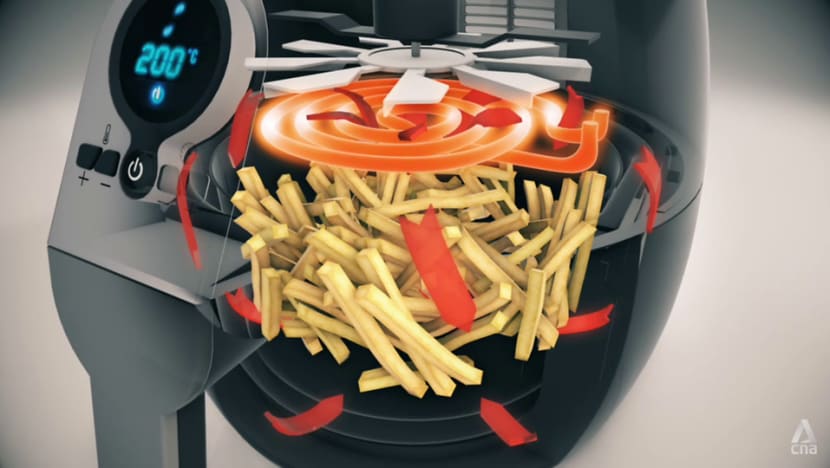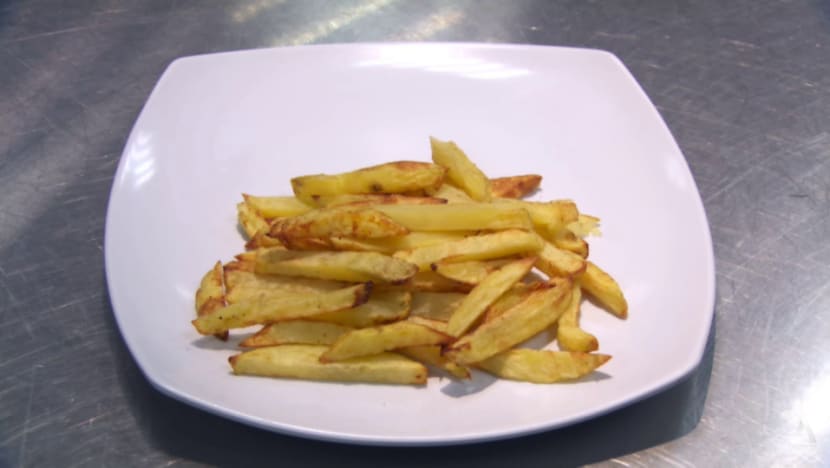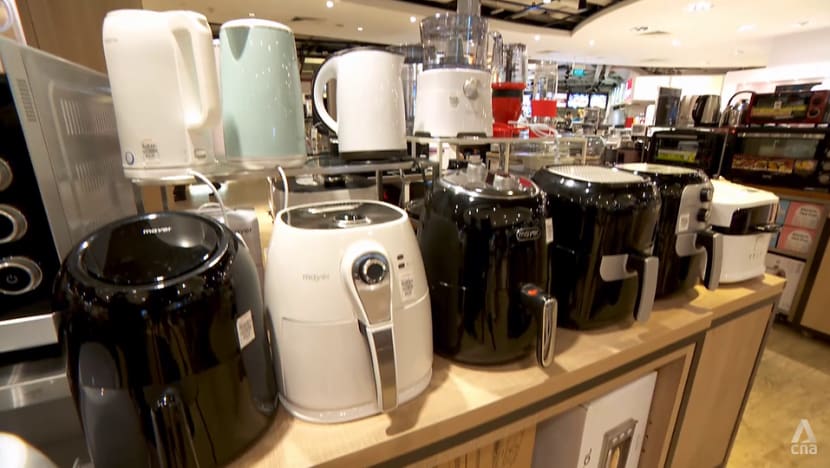The real deal on air-frying: Is it that much healthier than deep-frying food?
In recent years, air-frying has been heating up kitchens round the world, including Singapore. But does this cooking method bring with it health concerns? The programme Talking Point gets its teeth into the issues.

Consumers cannot seem to get enough of deep-fried foods. But what about air-frying them?
SINGAPORE: Can you have fried food without feeling guilty, knowing that it is unhealthy?
This is what manufacturers of air fryers promise — great-tasting food with minimal fat. Some even claim a fat reduction of up to 90 per cent as air-frying does not require oil.
And people are buying into it. The global air fryer market is expected to reach US$1.18 billion (S$1.56 billion) in size by 2026, up from US$680 million in 2019, according to brand and consulting firm KBV Research.
Air-frying involves creating and circulating hot air to “quickly cook the surface layer” of food and “quickly dry it out” for that fried, crunchy texture, noted food scientist Zhou Weibiao.

Adding just a “touch” of oil can “bring the air-fried food closer to the deep-fried one” — minus the calories — said the professor, who heads the National University of Singapore’s Department of Food Science and Technology.
But caloric intake aside, how much healthier is air-fried food?
To find out, the programme Talking Point selected three everyday foods: Chicken wings, selar kuning (yellow-banded scad, the fish that often accompanies nasi lemak) and French fries.
One set was air-fried, the other was deep-fried, and both sets were tested for saturated fats, trans fats and cholesterol.
The laboratory test results showed that the air-fried chicken wings had 38 per cent less saturated fats than the deep-fried version, while the air-fried selar kuning and chips had about 53 per cent less saturated fats.

The air-fried chicken wings also had 55 per cent less trans fats and 25 per cent less cholesterol than the deep-fried version.
READ: This is what happens if you eat too much fried chicken
There was little to no difference, however, in trans fat levels between the air-fried and deep-fried versions of selar kuning and French fries.
Nutritionist Carolyn Stephen of Singapore Polytechnic’s Food Innovation and Resource Centre attributed this to the fact that the fish and potatoes had little trans fat in the first place.
As for cholesterol levels, there was only a 1 per cent difference between the two versions of selar kuning. Fish is naturally low in cholesterol, she noted, while potatoes “don’t have cholesterol because it’s a plant-based food”.

THE ACRYLAMIDE TEST
The chips were also tested for acrylamide, a chemical that forms when certain types of starchy foods, such as potatoes and bread, are cooked at high temperatures. That includes the frying process.
Research has suggested that acrylamide in food has the potential to cause cancer. And in February, tests carried out by the Hong Kong Consumer Council found acrylamide in the chips fried in various models of air fryers.
The levels ranged between 102 micrograms (μg) per kilo and 7,038 μg/kg, with samples from six of the 12 air fryer models containing acrylamide that exceeded the European Union benchmark of 500 μg/kg.
For the Talking Point samples, the test results showed a huge spike in acrylamide: The deep-fried potatoes contained less than 10 μg/kg, but the air-fried ones contained 1,400 μg/kg.
WATCH: Can air fryers cause cancer? 3 ways to reduce this risk (2:49)
Stephen said she understands if this “raises some concern”. The World Health Organisation (WHO) has described acrylamide as a health concern, although she noted the caveat that the evidence on “what’s safe and what’s not safe” in humans is “lacking”.
“A lot of studies that have been done in the area of acrylamide have been based on lab animals,” she said.
The WHO has called for more long-term studies of acrylamide levels in food and the risk exposure. Accordingly, Singapore has not yet established a regulatory benchmark for acrylamide intake, she noted.
On its website, the Singapore Food Agency states that the information available so far “reinforces general advice on healthy eating, including moderating consumption of fried and fatty foods”.

To reduce the build-up of acrylamide, Philips Asean Pacific personal health leader Nicholas Lee said consumers should also take note of three factors: Cooking time (not too long), cooking temperature and preparation.
Talking Point host Sharda Harrison had air-fried her potatoes for 14 minutes at 200 degrees Celsius, while the deep-fried version was on medium to high heat for eight minutes. Lee, however, recommended cooking them at 180° Celsius “or slightly below”.
“If you’re cooking fresh potatoes, 160 (degrees) for the first part and then 180 (degrees) for the second part … would reduce the quantity of acrylamide that forms,” he said.
As for the preparation, soaking potatoes before frying them was one of his tips. “That’ll remove a lot of the starch and … sugar content (which) influence the formation of acrylamide,” he said. “It actually makes the fries taste better.”

He advised against storing potatoes in the fridge at very low temperatures, which would increase the sugar content and therefore the amount of acrylamide.
Consumers can also avoid overcooking by sticking to “that golden brown texture that you’re looking for in beautiful, home-made fries”, he added. Darker crusts indicate higher acrylamide levels.
AIR-FRIED HAWKER FOOD?
As a cooking option at home, air-frying may be increasing in popularity — one brand in Singapore saw air fryer sales grow by 50 per cent between 2019 and last year — but eating out is a different matter.
Industrial-grade air fryers are not readily available, nor are Singapore’s hawkers putting air-fried dishes on the menu.

It is not for lack of demand — a 2017 Nielsen online survey showed that 74 per cent of Singaporean respondents were willing to pay more for foods that promote health benefits.
Not all foods, however, are suitable for air-frying, said blogger Erinna Chng, who was previously hired by a leading brand to try out air fryer-friendly recipes.
Dishes fried in batter, such as Indian rojak and banana fritters, would “create a mess in the air fryer” as it does not have the oil to “set the batter”.
“I think western (food) stalls that mainly use frozen pre-fried food would be suitable for (air-frying); for example, if they cook the fries in the air fryer, it would help to drain the oil,” she added.
“Air fryers actually work for stalls that don’t totally depend on frying. For example, nasi lemak stalls (could) air-fry their chicken wings and fish. The wonton noodle (stalls) can pre-cook their fried wontons beforehand and … reheat using the air fryer.”

To put theory to the test, Kong Chee Chiew, assistant general manager of Fatty Bom Bom’s chain of western food stalls, agreed to offer air-fried versions of three side dishes.
Using three air fryers with the biggest capacity Talking Point could find, his team air-fried roasted wing sticks, Cajun wings and Cajun onion rings for lunch.
At the end of the one-hour experiment, most of the diners who tried the items enjoyed the taste and said they would love the air-fried dishes to be permanent options on the menu.
Kong does not think it is possible, however, to completely switch from deep-fried to air-fried meals one day. “Customers normally don’t want to wait too long (at) lunchtime,” he said. “(The air fryer) is slow … (and) too small.”
WATCH: The full episode — Is air-fried food really healthier? (22:04)
But he would consider air-frying if bigger, industrial-size air fryers that can handle a high volume of orders were available.
Until then, said Harrison, citing the health benefits, “I’ll just have to air-fry at home when I’m craving for something deep-fried”.
Watch this episode of Talking Point here. The programme airs on Channel 5 every Thursday at 9.30pm.















